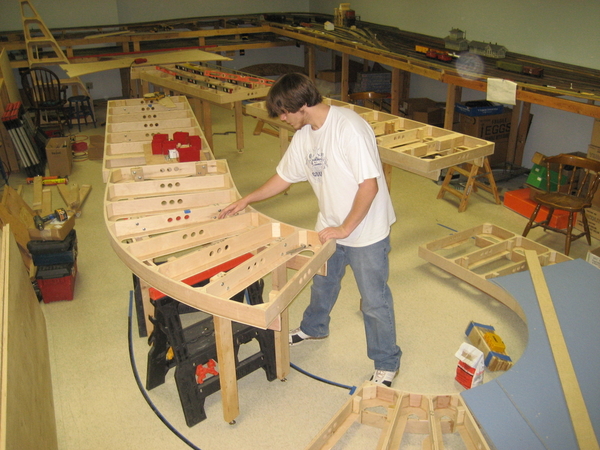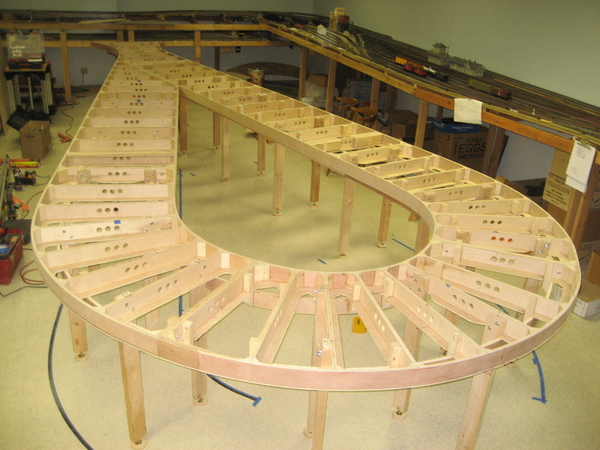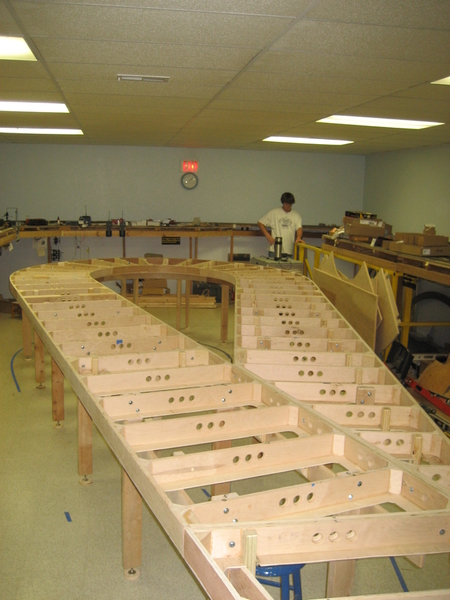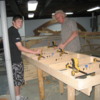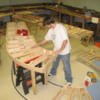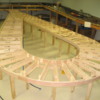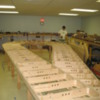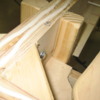I am getting ready to try and build benchwork, again. Will 1x4's be strong enough to support climbing on top of the layout. I weigh about 207. I tried using 2x4's and that was a disaster that I don't want to repeat as they warped and twisted so bad that I scrapped them. Lowe's and Menards has some good pricing on these and are supposed to be prime grade 1x4's.I will space them on 16" centers and rip some in half to make L girder joists. I also looked into birch plywood but it's $50.00 a sheet so that's to expensive. Also looked into MIANNE can't afford that either. I have to get this right this time. I have about 868 sq. feet, maybe a little more to build my layout. Thanks in advance for all replies.
Replies sorted oldest to newest
My layout was always made out of 1 by 4's. I'm 250 and I would climb all over it and never had an issue. Go with half inch plywood and make sure to put a brace where the two sheets come together.
If your layout requires that you walk around on it, you have the wrong design, room or scale. Really. Never mind the lumber. Even - or especially - with layouts, Less is often More.
Inconvenience is the enemy of enjoying a layout, and climbing around on the layout has to top the inconvenience list.
Better to go to HO or S is it helps you access everything.
1" x 4"s will definitely be strong enough to support your weight. Used on edge, like joists, spaced at 24" on center, will be sufficient. Once the plywood top is fastened it acts like bridging between joists and will strengthen the entire assembly. I would not try to span more than 4'-0", with the 1 x 4s however.
I would use the 1 x 4s as is, i.e.. full size to make any L girders. Ripping them into 1 3/4" rips will compromise their strength.
Also make the legs using 1 x 4s in an L girder configuration.
If your layout will be free standing, not attached to any walls, you will need some diagonal bracing.
As for the table top, look into 1/2" OSB. There's no need to use birch plywood.
D500 posted:If your layout requires that you walk around on it, you have the wrong design, room or scale. Really. Never mind the lumber. Even - or especially - with layouts, Less is often More.
Inconvenience is the enemy of enjoying a layout, and climbing around on the layout has to top the inconvenience list.
Better to go to HO or S is it helps you access everything.
I totally disagree. Our layout was not all that large, however by using 1"X4" lumber, with a 1"X 2" glued on the top in the "L girder" configuration, up to 5 BIG adults could be up on top of the layout (on hands & knees) laying track, soldering wire feeds, ballasting and doing scenery. The layout was fee-standing and not connected to anything, yet it never moved at all, even if you bumped into a corner.
D500 posted:If your layout requires that you walk around on it, you have the wrong design, room or scale. Really. Never mind the lumber. Even - or especially - with layouts, Less is often More.
Inconvenience is the enemy of enjoying a layout, and climbing around on the layout has to top the inconvenience list.
Better to go to HO or S is it helps you access everything.
The layout will have plenty of access area's. This will not be a giant table and I am leaving 2' around the back and sides. No way would I go to HO. I have wanted a large layout since I was a kid. Now I have a 1200 SQ' building just for trains.
rattler21 posted:Ever try to build a castle on sand? A few dollars extra on legs for your layout will pay dividends in the long run. Lumber yards have decent pieces of wood which may be a bit pricier but may also better suit your purpose. If you're building a twenty year layout, another $50 spent on lumber won't make a bit of difference one way or the other in the budget but may save you a lot of headaches in the future. John in Lanisng, ILL
I will have 1x4 L girder style legs. One thing Dad taught me was to do it right or don't do it.
Should be no problem with using 1 x 4's for the framing but I did use 2 x 4's for the legs for extra support and they also take screw-in type levelers very easily.
Dan Padova posted:1" x 4"s will definitely be strong enough to support your weight. Used on edge, like joists, spaced at 24" on center, will be sufficient. Once the plywood top is fastened it acts like bridging between joists and will strengthen the entire assembly. I would not try to span more than 4'-0", with the 1 x 4s however.
I would use the 1 x 4s as is, i.e.. full size to make any L girders. Ripping them into 1 3/4" rips will compromise their strength.
Also make the legs using 1 x 4s in an L girder configuration.
If your layout will be free standing, not attached to any walls, you will need some diagonal bracing.
As for the table top, look into 1/2" OSB. There's no need to use birch plywood.
All of the above, with one addition. If you expect the benchwork to be permanent, run a bead of glue or liquid nails on each 1x4 before screwing the plywood or OSB down. This will add a LOT of strength and rigidity.
If you have a genuine lumber yard slice a 4 x 8 sheet of shop grade Birch/Maple plywood into 3 1/2" strips 8' long it will yield 13 pieces. The per piece will come in about $4.50 to $5.00 aprox. This will provide the most stable of benchwork frames.
Solid dimensional lumber will warp. Can not give an account of the many solid wood layouts I have had to straighten.
For decking the best deal is Advantech at 84 lumber for about $30.00 per 4 x 8 x 3/4" sheet. The density makes it much quitter than 1/2" plywood or OSB.
For demonstration purpose I built a 200' long around the wall layout using all popular benchwork methods and you can hear the difference as the train moves from one construction style to another.
1 x 4 (3/4 x 3 1/2) plywood sides and cross members on 16" centers
13' x 29' staging loop. Floor taped to determine aisle size restrictions.
Predrill wire management holes and run most wires b/4 decking.
Below: beads of silicone on all mating surfaces with decking pre positioned on dowels and gently clamped in place with gussets holding plywood butting edges even. Helps in sound control.

I have now retired from benchwork to finish my own RR.
Attachments
I totally agree with Tom T on using ripped 3/4 plywood as your framework. I did exactly that with our club's display layout years ago, and the sections show no sign of warping or bowing. I screwed and glued all sections when assembling them. We don't walk on our sections, and were interested more in light weight for ease of portability and transfer from trailer to set-up site. That's why we used 1" and 2" foam for the tops. Here are a few photos of the construction:



The sections are held together upon assembly with carriage bolts and wing nuts. The legs (again for portability) are 2" pvc pipes with carriage bolts on the ends for adjustment on irregular floor surfaces. Again, not for walking on, but with 3' widths, it's not necessary.
Attachments
Dennis posted:I used 1"x4" over my entire layout. 1/2" plywood on top.
Me too. It would be even better to do the ripped plywood method but I haven't had any issues with the 1x4's. I did cut 2x4 triangles to block the corners. Super strong.
All,
I've used 2x4 lumber, as well as 1x4 and confidently will say that both are quite satisfactory for layout (1800 sq ft) instruction. I have not yet used 3/4" plywood, but who knows what the future will bring. Surface (top) lumber of choice has been 1/2" sheathing plywood. Tip: if there's a contractor building homes hear you, ask if you can have his cutouts and sheathing trim pieces. The pieces come free to you, and it saves him/her tipping fees at the landfill.
What is unequivocally, and persistently true is that quality of the lumber makes ALL the difference in the world. Use only first quality kiln-dried doulas fir 2x4s and buy them from a REAL lumber dealer. Good top grade 1x4s are your other option. Run as fast as you can from "twisted sister" pine at any of the big box stores!
Local lumber folks are more than happy to let you pick your lumber if needed, especially if you explain what you're doing. The few additional pennies you will pay for that will more than offset the hours spent with crappy lumber, or worse, with a layout that changes shape with every season.
Don
Don Sierakowski 111617 posted:All,
I've used 2x4 lumber, as well as 1x4 and confidently will say that both are quite satisfactory for layout (1800 sq ft) instruction. I have not yet used 3/4" plywood, but who knows what the future will bring. Surface (top) lumber of choice has been 1/2" sheathing plywood. Tip: if there's a contractor building homes hear you, ask if you can have his cutouts and sheathing trim pieces. The pieces come free to you, and it saves him/her tipping fees at the landfill.
What is unequivocally, and persistently true is that quality of the lumber makes ALL the difference in the world. Use only first quality kiln-dried doulas fir 2x4s and buy them from a REAL lumber dealer. Good top grade 1x4s are your other option. Run as fast as you can from "twisted sister" pine at any of the big box stores!
Local lumber folks are more than happy to let you pick your lumber if needed, especially if you explain what you're doing. The few additional pennies you will pay for that will more than offset the hours spent with crappy lumber, or worse, with a layout that changes shape with every season.
Don
That's the problem I ran into. Bought 2x4's at the local lumber yard. They were straight when I bought them but after being in the train building which is heated and air conditioned plus a dehumidifier they warped after I had 28' of table built. It is extremely hard to find good lumber around here. The 1x4's I mentioned using I have my choice of species from pine, oak or poplar.
I have used 1 x 4 pine in the L girder construction method. The only change I made on the last 2 sections (16 foot long L girders with 4 legs) is that I used 1 x 4 mahogany decking or meranti (same species) for the longer L - girders. I discovered this wood at work, it costs about 60% more than the pine, but is much stronger and heavier, and I hate excessive number of layout legs as I do alot of cruising around underneath on my creeper. If you find a lumber yard that stocks it, it's used for high end decking for folks that don't want PVC Azeks decks... It runs around $1.60 per running foot. My local lumber yard sells clear select pine ( 1 x 4 ) for $1.05 per foot, and #2 pine (1 x 4) for $0.60 per foot.
Having said that, my son and I installed a ceiling above the first phase of the layout (23' x 20') after it was built and in place which required getting up on the layout in most places, he weighs about 225 and I weigh in at 205. That was built with 1 x 4 pine L girders, and 1 x 4 pine joists.... No problems... As pointed out over and over again here on the forum, 2 x 4's are overkill and most will warp and twist, 1 x 4 produce a much better finished product without the headaches of warping and twisting... All my legs are 2 x 2 any larger in my opinion is overkill, and you can still install a 3/8 x 16 Tee Nut in the bottom of the leg for height adjustment, I use 3/8 x 16 carriage bolts with the rounded head.
PLEASE do NOT climb on top of your layout. It is an inconvenience, will become tiresome quickly, will be super expensive to correct in change. Think about this for a second. What will happen to your scenery on your lap if you are up on top of it climbing around?
It is really poor poor planning to do something like that. I'm not trying to be critical or a pain in the rear. I'm trying to save you a lot of pain time and trouble. Too many railroads in the past were spaghetti bowls of track looping around with no Rhyme or Reason with many spots on them that couldn't possibly be reached. That is a recipe for disaster.
Always keep everything within 30 in of reach out of an absolute maximum. That means cut out access holes or have aisleways along your layout where you can easily walk up and reach everything. Don't do it to yourself! Please go to my YouTube video for the glacier line and check out the video concerning reach the title of it is something to the effect of don't do it to yourself.
feet posted:I will have 1x4 L girder style legs. One thing Dad taught me was to do it right or don't do it.
My dad was a perfectionist when it came to building anything and the one thing he drilled in my head as a young lad was that you'll always find time to do it right the 2nd time so make darn sure you take the time to do it right the 1st time.
Tom Tee, how did you bend such graceful curves using the plywood framing?
Dan Padova posted:As for the table top, look into 1/2" OSB. There's no need to use birch plywood.
Gotta' disagree with the OSB, I've seen too many issues with it swelling to consider it's use for my layout. I'll spend the extra money for plywood!




